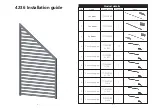
A
Caring for Connectors
60
Keysight N4000/1/2A Operating and Service Manual
Introduction
Recent advances in measurement capabilities have made connectors and
connection techniques more important than ever before. Damage to the
connectors on calibration and verification devices, test ports, cables, and other
devices represent an increasing burden in downtime and expense.
This Appendix will help you get the best performance from all coaxial microwave
connectors:
– To know what to look for when cleaning and inspecting them, in order to
preserve their precision and extend their life.
– To make the best possible microwave connections, improving the accuracy
and repeatability of all of your measurements, saving both time and money.
Connector part numbers
Refer to the latest edition of the
Keysight RF & Microwave Test Accessories
Catalog
for connector part numbers.
Handling and storage
Microwave connectors must be handled carefully, inspected before use and when
not in use, stored in a way that gives them maximum protection. Avoid touching
the connector mating plane surfaces and avoid setting the connectors
contact-end down, especially on a hard surface.
Never store connectors with the contact end exposed. Plastic end caps are
provided with all Keysight connectors and these should be retained after
unpacking and placed over the ends of the connectors whenever they are not in
use. Extend the threads of connectors that have a retractable sleeve or sliding
connector nut, then put the plastic end cap over the end of the connector.
Above all, never store any devices loose in a box or in a desk or a bench drawer.
Careless handling of this kind is the most common cause of connector damage
during storage.
















































